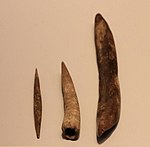Levantine Aurignacian
Appearance
Epipaleolithic ) |
parietal art in Europe.[5]

The Levantine Aurignacian (35,000-29,000 BP, calibrated, 32,000-26,000 BP, non-calibrated).
Levantine Aurignacian period
Similarities with Aurignacian are found in the manufacture of blades and in the processing of bone tools.[6]
The Levantine Aurignacian follows chronologically the Emiran and Early Ahmarian in the same area of the Near East, and closely related to them.[7]
The carving of a horse with traces of a layer of ocher painting from
parietal art in Europe.[11]
The Levantine Aurignacian is part of the technological shift from the
Homo sapiens out of Africa.[13] From this stage, the first modern humans probably migrated to Europe to form the beginning of the European Upper Paleolithic, including the Aurignacian culture.[13] There is a possibility that the Levantine Aurignacian was the result of reverse influence from the European Aurignacian, but this remains unsettled.[12]
Phases
- Upper Paleolithic III (lower Antelian).
- Upper Paleolithic IV (upper Antelian): proliferation of burin types and decrease in the number of Font-Yves points. First and almost only use of bone for tools in the region, very rare in any case.
- Upper Paleolithic V (Athlitian): specialization of Antelian with a comeback of the Chatelperronianknives of the Emiran.
Next period: the Kebaran microlithic culture
By the end of the Levantine Aurignacian, gradual changes took place in stone industries. The first phase of the
Kebaran, lasts from 20,000 to 12,150 BP.[14] Small stone tools called microliths
and retouched bladelets can be found for the first time. The microliths of this culture period differ greatly from the Aurignacian artifacts.
Sites
| The Paleolithic |
|---|
| ↑ Pliocene (before Homo) |
| ↓ Mesolithic |
- Central Negev sites D14, D18, D22, D27 A,B[15]
- El-Quseir[15]
- HaYonim Cave D[15]
- Kebara Cave D[15]
- Ksar Akil, shelter VII[15]
- Raqefet Cave, level III-IV[15]
- Umm el Tlel[15]
Artifacts
-
el-Wad Cave, 250,000-22,000 BP Israel
-
HayonimCave, 28,000 BP.
-
Aurignacian Culture bone tools (needle, points and tools for punching holes), Hayonim Cave, 30,000 BP.
References
- ISBN 9780870994708.
- ^ "Horse from Hayonim Cave, Israel, 30,000 years" in Israel Museum Studies in Archaeology. Samuel Bronfman Biblical and Archaeological Museum of the Israel Museum. 2002. p. 10.
- ^ "Hayonim horse". museums.gov.il.
- ^ a b Bar-Yosef, Ofer; Belfer-Cohen, Anna (1981). The Aurignacian at Hayonim Cave. pp. 35–36.
- ISBN 9780822339380.
- ^ ISBN 9781107006980.
- ISBN 9781107006980.
- ISBN 9780870994708.
- ^ "Horse from Hayonim Cave, Israel, 30,000 years" in Israel Museum Studies in Archaeology. Samuel Bronfman Biblical and Archaeological Museum of the Israel Museum. 2002. p. 10.
- ^ "Hayonim horse". museums.gov.il.
- ISBN 9780822339380.
- ^ a b c Williams, John K. (2006). "The Levantine Aurignacian: a closer look" (PDF). Lisbon: Instituto Português de Arqueologia (Trabalhos de Arqueologia Bar-Yosef O, Zilhão J, editors. Towards a definition of the Aurignacian. 45): 317–352.
- ^ ISBN 9780226027524.
- ^ Simmons, 47-48
- ^ ISBN 9781107006980.
Bibliography
- Simmons, Alan H., The Neolithic Revolution in the Near East: Transforming the Human Landscape, 2007, University of Arizona Press, ISBN 978-0816529667, google books
- M. H. Alimen and M. J. Steve, Historia Universal siglo XXI. Prehistoria. Siglo XXI Editores, 1970 (reviewed and corrected in 1994) (original German edition, 1966, titled Vorgeschichte). ISBN 84-323-0034-9



